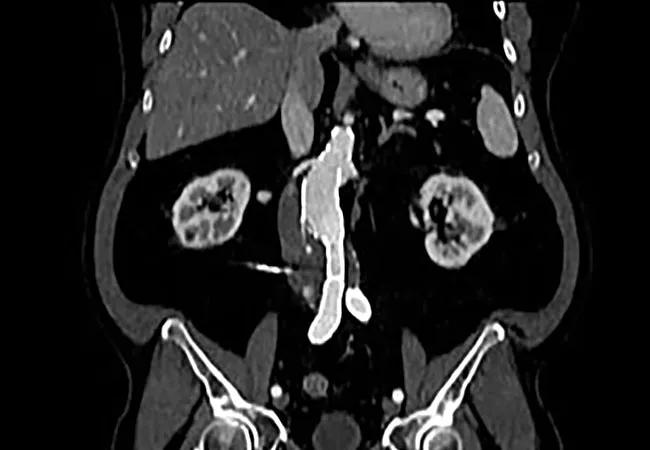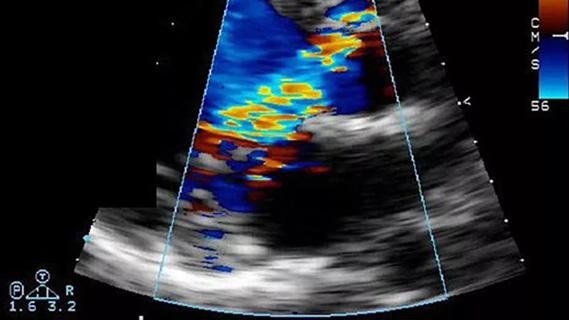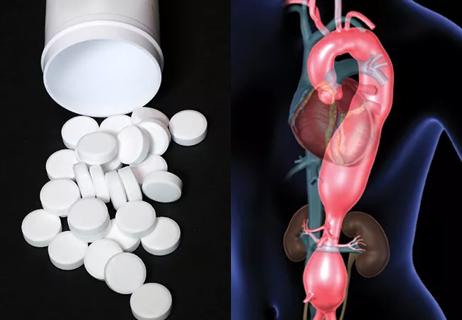Recent Cleveland Clinic experience reveals hundreds of cases with anatomic constraints to FEVAR

Conventional open surgery is still an important strategy for patients needing elective repair of an abdominal aortic aneurysm (AAA), despite widespread use of less-invasive endovascular aneurysm repair (EVAR) options. Many patients present with anatomic features — most commonly a short aortic neck or a tortuous iliac artery — that preclude the use of a fenestrated endovascular aneurysm repair (FEVAR) device according to the device’s instructions for use.
Advertisement
Cleveland Clinic is a non-profit academic medical center. Advertising on our site helps support our mission. We do not endorse non-Cleveland Clinic products or services. Policy
So conclude authors of a retrospective review of adults who underwent elective open surgical repair of an AAA at Cleveland Clinic over an 11-year period after fenestrated endografts became available. The review, characterizing patient demographics and indications for surgical repair, was recently published in Annals of Vascular Surgery (2025;122:26-33).
“More than 90% of the 849 patients who underwent elective open surgical repair in our study had at least one anatomic limitation for FEVAR, which evidence indicates is associated with poorer outcomes if treated with an endovascular intervention,” says corresponding author Francis Caputo, MD, Vascular Surgery Director of the Aorta Center at Cleveland Clinic. “Clearly there is still an important need for the availability of a surgical option.”
Open surgical repair of AAAs, first performed in the 1950s, was the standard of care before the development of EVAR in 1991. In 2012, the Zenith® Fenestrated AAA Endovascular Graft became available, extending eligibility to patients with a shorter aortic neck (as small as 4 mm) and involvement of up to three visceral vessels. Today, endovascular techniques — entailing less risk of operative mortality than traditional surgery — have advanced to the point that most patients with an unruptured infrarenal AAA undergo repair with an endovascular intervention.
However, when patients have anatomic characteristics that fall outside of endovascular device instructions for use, published reports indicate that they fare better with open surgical repair. Despite that, owing to the popularity of EVAR and FEVAR, the conventional surgical option is becoming scarce as surgeons are increasingly less likely to be trained or experienced in the required techniques and prefer to adapt endovascular methods to try to address anatomic challenges.
Advertisement
This study was designed to evaluate the need for open surgical repair in the era of FEVAR, using data from a single institution where open AAA repair is still commonly performed alongside its endovascular alternatives.
The study reviewed CT angiograms of all adult patients who underwent open surgical elective AAA repair from January 2012 through December 2022 (N = 849; average age, 69 ± 8 years; 75.5% male).
Of these, 786 patients (92.6%) had anatomy outside the instructions for use of the Zenith FEVAR graft, with 60% of the total having at least two anatomic constraints, including the following:
During the same period, 1,573 patients at Cleveland Clinic underwent endovascular AAA repair (1,315 infrarenal EVAR and 258 FEVAR).
“Despite rapid advances in EVAR and FEVAR technology, anatomic suitability still commonly limits candidacy for endovascular repair,” says Dr. Caputo. “A short aneurysm neck and a tortuous iliac artery were the most frequent constraints, posing significant challenges to intervention with current devices.”
According to the study authors, the literature reports multiple problems associated with poor adherence to anatomic guidelines for endovascular devices, including increased risk of endoleaks, higher perioperative mortality, and greater need for reintervention at one year and for late open surgical conversion, with the latter being associated with increased morbidity and mortality. In addition, durability of the newer devices has not been well established.
Advertisement
The authors note that several institutions, including Cleveland Clinic, have explored off-label applications of new designs of fenestrated endovascular devices that can extend their use to a wider population. However, these applications are typically explored under investigational device exemptions and have not yet undergone extensive clinical trials.
“At Cleveland Clinic, we follow strict instructions-for-use protocols from the manufacturers of endovascular devices, so this study reflects our conservative approach,” says co-author Ali Khalifeh, MD, of Cleveland Clinic’s Department of Vascular Surgery.
Drs. Caputo and Khalifeh note that not every center that performs EVAR and FEVAR for elective AAAs can be expected to have the expertise to offer an open surgical approach. However, considering that many patients with the need for AAA repair present with anatomic constraints to EVAR and FEVAR, it is imperative that the surgical option remain available at high-volume, regional referral aortic centers.
“Comprehensive vascular surgery training should continue to include open surgical repair for AAAs so that optimal therapy remains available,” urges Dr. Khalifeh. “This can be fostered by subspecialty training at quaternary referral centers where these surgeries are commonly performed.”
Advertisement
Advertisement

New Cleveland Clinic data challenge traditional size thresholds for surgical intervention

Study finds comparable midterm safety outcomes, suggesting anatomy and surgeon preference should drive choice

New review distills insights and best practices from a high-volume center

Blood test can identify patients who need more frequent monitoring or earlier surgery to prevent dissection or rupture

Multicenter pivotal study may lead to first endovascular treatment for the ascending aorta

Residual AR related to severe preoperative AR increases risk of progression, need for reoperation

Large cohort study finds significant effect in men and nonsmokers

Impacts include major emphases on multidisciplinary teams, shared decision-making